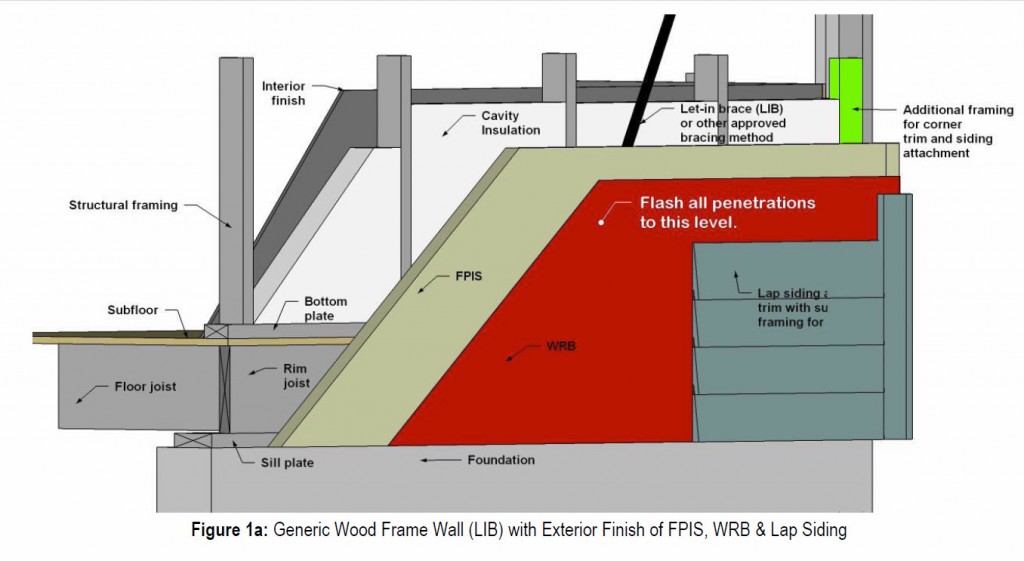Expanding Use of Plastic Insulation
By Christopher J. Naum, SFPE on Feb 09, 2019 with Comments 0
Foam Sheathing Makers Gain Major Success at ICC Code Hearing By Approval of Proposal Expanding Use of Plastic Insulation
 The Foam Sheathing Committee (FSC) of the American Chemistry Council (ACC), through an industry effort, achieved an important change in gaining broad acceptance of a performance-based standard for the use of foam insulation products in all code complying commercial applications during the recent International Building Code (IBC) Final Action Hearings in Portland, Oregon. The International Code Council (ICC) approved for inclusion in the 2015 International Building Codes the Structural Building Components Association’s (SBCA) FS 100-2012: Standard Requirements for Wind Pressure Resistance and Foam Plastic Insulating Sheathing Used in Exterior Wall Covering Assemblies.
The Foam Sheathing Committee (FSC) of the American Chemistry Council (ACC), through an industry effort, achieved an important change in gaining broad acceptance of a performance-based standard for the use of foam insulation products in all code complying commercial applications during the recent International Building Code (IBC) Final Action Hearings in Portland, Oregon. The International Code Council (ICC) approved for inclusion in the 2015 International Building Codes the Structural Building Components Association’s (SBCA) FS 100-2012: Standard Requirements for Wind Pressure Resistance and Foam Plastic Insulating Sheathing Used in Exterior Wall Covering Assemblies.
This is an important development as this standard was just recently approved by the American National Standards Institute. Inclusion of this standard in the 2015 edition of the IBC was unusually quick and efficient due to the hard work by industry to create the needed consensus. This standard will set a solid performance foundation for foam plastic insulating sheathing (FPIS) products and expand the use of these products where wind pressure resistance requirements in commercial construction have been constrained in the past. This will help architects, engineers, and builders use FPIS products such as continuous insulation in exterior wall covering assemblies to meet the energy efficiency demands of the International Energy Conservation Code while also meeting all the requirements for wind pressure performance.
This technical standard is important for designers, builders and, ultimately, the public in establishing structural resistance due to wind pressure and quality control requirements that substantiate full code compliance for FPIS products.
Responding to this development, Greg Bergtold, Chairman of the ACC-FSC stated, “This is a significant outcome that will expand the proper use of foam sheathing products in commercial construction and demonstrates industry’s effectiveness in finding solutions when working together.”
This code change is the result of hard work from a range of stakeholders to demonstrate the technical basis for FPIS products in wall assemblies led by Jay Crandell, P.E., technical consultant for the ACC’s FSC, with support from members of the FS 100 Project Committee, builders, building officials, fastener companies, the insurance industry and the forest products industry. This is a significant development in support of FSC’s mission to create positive and proactive solutions to enhance safety through the building codes and promote the proper use and installation of foam sheathing in the construction industry.
The Foam Sheathing Committee (FSC) of the American Chemistry Council focuses on developing solutions to building code issues, in close coordination with ACC’s Plastics Building and Construction Team and ACC’s Center for the Polyurethanes Industry, and promoting the sound technical use of foam sheathing to the construction industry.
Members:
FSC’s primary membership base is manufacturers of rigid plastic cellular foam insulation products including expanded polystyrene (EPS), extruded polystyrene (XPS), and polyisocyanurate or polyiso (PIR).
Technical Resources:
With the support of members and aligned industry groups, FSC is pleased to offer a wealth of technical resources on foam sheathing, including properties, applications, installation, and building and energy code considerations.
Learn More:
- Overview of Foam Sheathing for Exterior Walls
- Foam Sheathing Materials and Properties
- Foam Sheathing Applications
- Foam Sheathing and the Building Code
- Foam Sheathing and the Energy Code
- Construction Details for the Use of Foam Plastic Insulating Sheathing (FPIS) in Light-Frame Construction
- Foam Sheathing on Foundations
- About FSC
Construction Details; HERE
Why is Foam Sheathing Insulation being used more than ever before?
Residential housing design continues to move towards the development of high performance sustainable building systems. To be sustainable, a building must not only be efficient and durable but also economically viable. From this, new methods of enclosure design have been examined that provide high thermal performance and long-term durability but also take opportunities to reduce material use (including waste), simplify or integrate systems and details, and potentially reduce overall initial costs of construction.
One concept relating to enclosure design is to incorporate the use exterior foam insulating sheathing into the construction of the wall assembly. As with any building enclosure system, appropriate detailing for the management of water, vapor, and energy transfer are necessary.
Foam Material Properties:
There are three main types of insulating sheathing currently being used in the industry: Expanded
Polystyrene (EPS), Extruded Polystyrene (XPS), and Polyisocyanurate (Polyiso). 
Each of these products all has a different set of physical properties that will affect the dynamic of the wall assemblies in regards to the transmission and management of heat and moisture.
Types of Foam
Insulating foam sheathings are split into two basic categories: 1) thermoplastics, 2) thermosets. Both EPS and XPS foams are thermoplastic foams, while Polyisocyanurate is a thermoset foam.
Thermoplastics
Thermoplastics are based on linear or slightly branched (non-cross linked) polymers. These foams have a definite melting range and will soften and melt at elevated temperatures. They are also more prone to react and degrade when in contact with some organic solvents as found in some paints, adhesives, and fuels.
Therefore it is important to only use manufacturer approved compatible materials when using thermoplastic foams.
Of the thermoplastic foams, EPS and XPS are the most common used in the industry. Both products are based on polystyrene resin and are considered to be closed cell.
The manufacturing of EPS involves the expanding of polystyrene beads to fill a mold. The densities of EPS foam can be varied if desired. Increased density results in increased thermal resistance and compressive strength. The density of the product also affects the vapor transmission. While EPS is a closed cell foam (slow water vapor and air transmission through the cell walls), the gaps between the cells will still allow for moisture to pass through the matrix. With increased density, these spaces are reduced and the ability of the foam to allow water transmission is reduced.
XPS foams are formed by mixing molten polystyrene with a blowing agent at the correct time, at an elevated temperature, and at an elevated pressure and then extruding the foam through a die to the atmosphere. This creates a more regular cell structure providing for better strength properties and higher water resistance that EPS foams. The density of XPS foams can also be varied, allowing for increased compressive strength, however due to the more regular cell structure, this has little to no effect on the vapor transmission properties.
Thermosets
Thermoset plastics are based on cross linked polymers. This will allow thermoset plastics to be used for higher temperature applications as they do not usually exhibit a melting range and will instead char and burn. Thermoset foams are also generally more resistant to solvents and chemicals.
The most common thermoset foam on the market is polyisocyanurate. While traditional polyurethane foams were created by reacting isocyanate with polyol (and other blowing agents, catalysts, and surfactants) polyisocyanurate foams can theoretically be created with no polyol, using only isocyanate reacting with itself (and other blowing agents, catalysts, and surfactants). In general though, commercial polyisocyanurate foam used in the market is really polyurethane foam modified with polyisocyanurate or a “blend” of the two foams. The use of the blend increases the fire resistance while maintaining the thermal resistance and strength of the material.
Additional Information:
Foam Plastic Insulating Sheathing Comparison of Fire Performance Link:
http://fsc.americanchemistry.com/Exterior-Walls/Continuous-Insulation-Educational-Presentation.pdf
Filed Under: Anatomy of Buildings • Buildings • Structural Systems
























